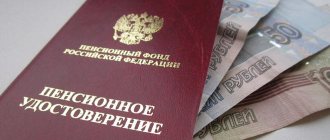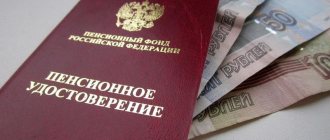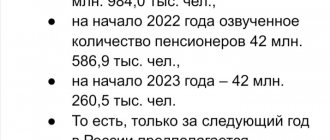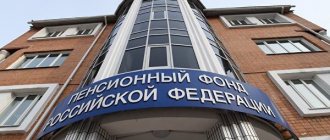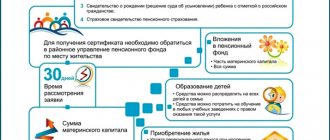The program, under which state co-financing of pensions is available, began operating back in 2008. The meaning of the program is that the future pensioner makes a contribution to the account of his future pension, and the state doubles the contributed amount. The peculiarity of this program was that entry into it ended in 2015. Now you can't get there. Another feature is that social transfers will not be co-financed, only those funds that the citizen will transfer.
How to receive the money?
Since pension co-financing has been completed, many would like to know how pensioners can receive money? Payments are made when applying for a funded old-age benefit by submitting a separate application to the Pension Fund. At the discretion of the inspector, payment may be:
- return one-time;
- divided into equal parts and paid over a certain period, for example, 5 or 10 years;
- pay for life.
On a note! The most popular option is divided into a period, and the most unprofitable is a lifetime payment (in this case, the increase in pension will be pennies every month).
Savings can be received not only by the participants of the state program, but also by legal successors - children (relative and adopted), husbands/wives, parents, brothers/sisters, grandchildren.
Savings will be paid in the event of the death of a state program participant if it occurs:
- before the pension is assigned or recalculated taking into account voluntarily contributed funds;
- after the appointment of an urgent benefit, which can be applied for by anyone, the balance from the pensioner’s personal account will be issued from the funded part (without taking into account the maternity capital, if it was used to form a social benefit for the deceased);
- after the pension has been assigned, but before the lump sum is issued - in this case, close relatives will be able to receive the money, but only if they lived with the deceased, as well as dependents (regardless of place of residence) within 16 weeks from the date of death. If there are no such persons, the money is redirected to the inheritance.
Expert opinion
Gusev Vasily Ivanovich
Lawyer with 7 years of experience. Specializes in the field of civil law. Has experience in developing legal documentation.
Important! If an indefinite payment of the funded part was initially arranged, that is, the amount was paid in equal monthly installments, the relatives will not receive the money.
To receive a pension increase, you must submit an application to the Pension Fund. Sometimes the inspector suggests writing three options and then choosing one - listing everything at once, in parts over a set period of time, or stretching it out over the rest of your life. The pensioner himself does not have the right to make such a choice.
If we are talking about payments to legal successors, then you will have to attach documents confirming the relationship. You must apply strictly within six months from the date of death of the program participant. If you miss the deadline, you will have to restore it through the court.
The package of documents is brought to the Pension Fund in person or sent by registered mail with a list of the attached papers and a notification. Within a month following the application, a decision is made on payments to legal successors.
In all cases, within 5 days from the date of the decision on approval/refusal, a notification is sent to the applicant. No later than the 20th day of the month following the month the decision was made, the money must be transferred.
When submitting an application, participants in the pension co-financing program were asked to choose a convenient option for how to receive money - in cash at the post office or by bank transfer to a bank account. Based on the selection, the transfer is made.
Succession of deposits in the event of death of the insured person
In unforeseen circumstances - in the event of the death of the insured person - his legal successors have the right to assign payment of pension savings. A citizen can determine the list of heirs in advance, draw up a will, indicating the shares in which his benefit will be distributed among future potential recipients. If a pension will has not been drawn up, the legal successors are considered:
- Primary relatives:
- children, including adopted children;
- parents;
- adoptive parents.
- Secondary relatives:
- brothers, sisters;
- grandmothers, grandfathers;
- grandchildren.
Secondary relatives have the right to claim inheritance of the deceased’s pension in the absence of primary ones. The funded pension of the deceased is assigned to his successors in 3 cases - if the death of the pensioner occurs:
- before assigning software or recalculating it;
- after making an urgent payment;
- after assigning a lump sum transfer that was not transferred and/or received by the pensioner.
How to pay?
Although it is no longer possible to join the state program, co-financing of pensions in 2021 continues. Those who submitted an application no later than December 31, 2014 continue to increase their old-age benefits with the support of the authorities.
Important! The first payment was due no later than January 31, 2015. Otherwise, participation in the program will be cancelled.
You can deposit amounts either in equal parts throughout the year, for example, a thousand per month (or other convenient amounts, but not less than 2 thousand per year), or in a one-time payment, say, 12 thousand at the end of the year. The money is deposited into a retirement savings account.
There are two options:
- pay in person at the bank (a payment form can be generated on the official website of the Pension Fund - https://www.pfrf.ru/eservices/pay_docs/);
- through the employer: you should submit an application in free form indicating the amount of payment (fixed amount or percentage of earnings).
Additional preferences
To attract citizens to endowment insurance, the state has provided a number of important preferences for them. These benefits are as follows:
- savings made are inherited;
- It is possible to obtain a tax deduction from the amount of contributions paid (but not more than 12,000 rubles per year).
Registration of the deduction is available through the employer or the Federal Tax Service. In the first case, you can apply before the end of the reporting period, in the second - only after its end, but you can receive immediately for the last 1, 2 or 3 years.
Read: Recalculation of pension after 40 years of work experience
Why did you turn around?
The average salary in the country is 36 thousand rubles, while more than 70% of workers receive much less. Financiers claim that making long-term savings in the current economic situation is only possible if you earn at least 60 thousand rubles, and only a small percentage of Russians receive that much.
Those who have good incomes are unlikely to choose a pension account for investment, because there are more profitable ways to increase savings, for example, regularly replenishing a bank deposit. And the withdrawal restrictions are minimal - I urgently needed money for treatment, so I went and got it.
What do they offer?
Everyone, without exception, is today concerned about the planned pension reform, some of the provisions of which have already begun to be implemented. What final form it will take is still unknown, but one of the innovations could be the IPC, which is considered today as an alternative to the unsuccessful idea of co-financing a pension.
At first glance, the idea of introducing the IPC seems interesting - citizens will be able to independently save for their old age, increasing the level of civic responsibility. When you retire, there will be no one to blame: what you have accumulated is what you get.
But experts do not yet see the possibility of linking the IPC with existing corporate programs for increasing pension payments, in which about 6 million Russians participate. They make annual contributions totaling 6 trillion rubles.
Corporate programs have been developed in various companies, within their framework, a portion of employee earnings is transferred to their future pensions - most of these programs have their own characteristics.
Expert opinion
Gusev Vasily Ivanovich
Lawyer with 7 years of experience. Specializes in the field of civil law. Has experience in developing legal documentation.
And where are the guarantees that Russians will be interested in IPK? And they will not just be interested, but will want to give up their current needs in favor of pension savings?
For motivation, experts suggest using effective tools:
- abolish income tax on contributions to non-state funds (today only contributions paid to the Pension Fund are not subject to personal income tax);
- increase the social tax for the return of paid personal income tax to 400 thousand rubles. (today its size is 120 thousand rubles);
- allow employers to deduct money contributed to the IPC from income tax, equating it to labor costs;
- the state should consider other tax benefits for participants;
- direct all additional deductions from employers for harmful and dangerous working conditions to corporate pension funds.
On a note! It is predicted that without serious incentives, the maximum number of people wishing to form an individual industrial complex will not exceed 2%.
Another important question remains unresolved: will participation in the IPC be voluntary? It was previously reported that only “auto-subscription” would allow the idea not to be put to rest: deductions from wages would be made automatically by the employer, but at any time the employee would be allowed to write a statement and leave the program.
This approach contradicts the law and legal norms of the Labor Code, so the Central Bank started talking about the idea of auto-registration, although the essence has not changed much. After being entered into a single database, each employee will be required to deduct from 1 to 6% of their salary to the funded part, and to withdraw they will again have to write an application.
It is still unknown what method the state will choose to co-finance pensions and maintain the pension system, the serious tests of which will begin in the mid-20s. Based on the reviews, it is obvious that participation in the scheme with doubling investments turned out to be a complete disappointment for many.
The essence of the pension co-financing program
Back in 2008, the Russian Government launched a program for co-financing pensions for Russian citizens. Initially, assistance was envisaged in the form of doubling voluntary contributions over 5 years (that is, until 2013). However, later they decided to extend the program further, as it received a great response from citizens.
The main goal of the ongoing program is to increase the standard of living of future retirees by increasing pension levels. What does the state offer to participants? Increase their voluntary contributions by 2 times.
However, there are limits on the amount of these contributions. So, the state is ready to double the amount from 2 to 12 thousand rubles per year.
If less funds are transferred, the money is not doubled. If the maximum threshold is increased, the state contributes 12 thousand rubles, but not more than this amount.
Examples
- Citizen Voronova participates in the co-financing program. Every year she makes the required voluntary contributions. In 2021, the amount of deductions amounted to 11 thousand rubles. The state also transferred the same amount to her account. That is, during this period, 22 thousand rubles accumulated in her account.
Special cases
The doubling is due to all participants who managed to join the program. However, some categories of citizens receive an increase of up to 4 times.
For example, if a person has not applied for an old-age insurance pension, but is entitled to it, then the amount of voluntary contributions for him increases 4 times. This means that the total amount can range from 10 to 60 thousand rubles per year.
Until what year is the program valid?
Participants may have a question: until what year can they pay additional contributions and be able to receive a tax benefit from them?
The co-financing program is designed for 10 years. Thus, the last participant will finish it in 2025. The amounts contributed after this period are no longer multiplied at the expense of the state, but grow only through investment. Since 2015, it is no longer possible to join the program. However, this does not mean that you cannot form pension savings to subsequently increase your payments. And in 2021, those who wish can choose a non-state pension fund and transfer funds there, however, they will no longer be multiplied by the state. Capital will grow only through investment.
At Sberbank, the country's largest non-state pension fund, you can sign up for an individual pension plan, creating savings that can be used until retirement age. In this case, you can independently choose the amount of contributions, the period for replenishing the account and the period of subsequent payments (at least 5 years). Like the capital of participants in the co-financing program, savings are invested, due to which they grow, provide the opportunity to receive a social tax deduction in the amount of 13%, are inherited and are not divided upon divorce. The amount of the first payment must be at least 1.5 thousand rubles, subsequent payments - at least 500 rubles. To create a pension plan, you need to contact Sberbank or fill out an application on the website.
Who can participate in the program?
The low level of pensions gives rise to a desire among older people to take part in co-financing. However, joining the program is no longer possible. The following factors are mandatory conditions for participation:
- before December 31, 2014, a person expressed his desire to participate in the program by submitting an application;
- before the end of January 2015, he made the first voluntary contribution.
Moreover, doubling the pension does not apply to all participants. So, if a person managed to join the program and make the first contribution, but was already a recipient of a pension, then he will not be able to receive a doubling from the state. All he is entitled to is an increase in his own pension capital.
It is noteworthy that the resulting payments with the participation of the state will be available to recipients only after they apply for a funded pension.
This video is unavailable
When to retire? New exit scheduleWho will be able to become a pensioner in 2021, and who will have to wait? Let's study the schedule together. In Russia, as everyone knows, pension reform begins on January 1, 2021. The main thing in it is to increase the retirement age by 5 years. This, according to the authorities, is the only way to increase payments to pensioners and fight poverty, which Vladimir Putin declared after his next assumption of the post of President of Russia.
The plans include increasing the average insurance pension to 24,000 rubles or up to 40% of the average salary and reducing the poverty level by half. But, since, as we all remember, there is no money, the citizens themselves must finance all these undertakings.
Calculation and transfer of contributions
Co-financing of pensions for working pensioners is carried out in accordance with Federal Law No. 56-FZ of April 30, 2008. The law defines the minimum and maximum amounts that are subject to doubling.
The Pension Fund of the Russian Federation was appointed responsible for the correctness and calculation of due contributions. What is his responsibility? Monitoring incoming amounts and drawing up applications for co-financing based on them. Next, the money is transferred to the regional Pension Funds of the Russian Federation within 10 days. Afterwards they are sent to non-state pension funds or management companies.
Let's sum it up
Thanks to the co-financing system, certain categories of citizens have formed a funded part of their pension. People who submitted an application within the deadlines established by law managed to increase their own savings. However, the state program operates for 10 years, so it is necessary to confirm your consent and transfer contributions.
Additionally, in the coming years, the state plans to develop the possibility of independently accumulating pensions in the form of an IPC. It is not yet clear how this program will operate, but experts suggest that not everyone will be able to become participants due to financial difficulties. To achieve interest in the new program, experts plan to create tax benefits and concessions.
Features of transferring funds
Contributions are voluntary, so citizens themselves are responsible for their transfer. You can deposit the desired amount in the following ways:
- Through the bank. To do this, just fill out a payment receipt, having previously received the details from your NPF. Moreover, the desired amount can be paid one-time or you can make small contributions every month. It is important to enter information about yourself (especially SNILS) carefully, eliminating the possibility of error. Otherwise, the money may go in the wrong place.
- Through the employer. Everything is even simpler here. The employee writes an application to the accounting department for the transfer of a voluntary contribution. It is drawn up in free form and contains information about the payer and recipient. The amount of the contribution itself can be fixed or determined as a percentage of salary.
The second option gives the opportunity to participate in co-financing not only for the state, but also for the employer. It can also make unlimited contributions for its employees. This provides special benefits. True, in practice, only a few employers make such contributions; most of them prefer to remain aloof.
An important feature of payments is the possibility of obtaining a tax deduction. The amount of the refund depends on the size of the payment. However, if the threshold of 12 thousand rubles is exceeded, no deduction is allowed for the excess amount.
The co-financing itself will continue until the program participant retires, but a prerequisite is the payment of DSA.
Methods for applying DSV
Money can be deposited into the account through any organization that has permission to conduct banking operations. After making the payment, within 20 days from the end of the quarter, you must send a copy of the payment receipt to the Pension Fund. Papers can be taken to the Pension Fund department, sent by mail, or sent through the Pension Fund of the Russian Federation website. You can also generate a payment receipt form on the website. To do this, you need to indicate that you are an insured person, select your region of residence, and also enter your full name, address, SNILS number and payment amount. The receipt generated by the system can be printed or downloaded in PDF format.
According to Article 5 of Law No. 56-FZ, contributions can be transferred not only independently, by depositing a certain amount into the account, but also through the employer. To do this, the employee must submit an application indicating the fact of participation in the state program, as well as the amount chosen for payment of DSA. Moreover, you can specify either a specific monetary amount or a percentage of wages that the employer undertakes to transfer to the fund monthly. DSV from salary will begin to be credited to the account from the 1st day of the month following the submission of the application. In the future, you can change the value of the DVA or completely abandon them by writing a corresponding application. Upon termination of the employment contract, the employer automatically stops payments.
Receiving funds
The main question from participants concerns the procedure for receiving payments. Funds doubled by the state can only be received upon the occurrence of an insured event. That is, a person, upon retiring due to old age or disability, receives all the payments due to him as part of a funded pension. Moreover, there are two options for issuing them:
- monthly;
- lump sum (provided that the accumulated savings are less than 5% of the insurance pension).
Self-receipt
To assign payments, the program participant himself submits an application to the Pension Fund of the Russian Federation. Additionally, other options are available. For example, you can contact the MFC for help, send an application by mail or register it on the State Services portal, the official website of the Pension Fund of the Russian Federation).
The package of required papers is small. It includes a Russian passport, SNILS, as well as papers confirming the right to receive an insurance pension. The last ones are usually entries in work books. They may be supplemented by other legal documents.
If a person has already retired, he does not need this package of papers. It is enough to simply fill out an application for receiving payments under the co-financing program. Payments usually begin within 2 months from the date of application to the Pension Fund of the Russian Federation.
Posthumously
Unfortunately, not all program participants live to retire. In this case, the law gives his heirs the right to receive the accumulated funds.
Moreover, it is assumed that the person himself can designate in advance who will receive what amount (share) of his savings. If he did not have time to express his will or did not want to, then relatives of the first and second stages can apply for payments.
Moreover, for the latter, payments are due only when there are no heirs of the first priority.
The legislation also limits the situations in which savings can be inherited. A prerequisite is the occurrence of death before the pension is assigned or its subsequent recalculation. For urgent and one-time payments, their inheritance is possible only after appointment (but if the money has not yet been transferred).
Unfortunately, recent news and practice show that after the appointment of permanent payments, it is impossible to inherit the remaining amount. This is one of the most significant disadvantages of the program. These also include the impossibility of joining it after 2015 and low doubling amounts.
How to withdraw savings from a non-state pension fund?
Citizens who transferred savings to a non-state pension fund have the right to apply to it for benefits after retirement. An application for transfer of savings is submitted in two cases:
- old age pension insurance is issued (repayment of contributions should be expected 2 months after submitting the request);
- the program participant retired early.
The funded part can be received before the established age if the citizen has the right to early retirement.
The application must indicate the method of receiving money: a one-time payment, an urgent or unlimited option. Full or partial payment is transferred after 2 months. Payments under the unlimited option are extended over 19 years. With the urgent option, savings are issued for a period of at least 10 years. A lump sum payment is transferred once every 5 years and can be up to 5% of the insurance portion.
If a participant in the state program applied for an urgent payment of savings, then in the event of his death, the heirs can count on receiving the rest of the funds. The legal successor is determined by the will. If there is no will, a close relative has the right to apply for benefits.
To receive savings, the heir applies to the NPF within 6 months from the date of death of the program participant. The applicant confirms with documented family ties and the fact of death. The NPF makes the decision to transfer funds within 1 month, and makes payments after the 15th.
What pension changes await Russians in 2021
In 2021, a number of changes have occurred and are still expected in the Russian pension market that are important for Russian citizens in terms of the formation of their current and future pensions. These events concern both the business of non-state pension funds and issues of calculation and accrual of insurance and funded pensions.
The retirement age, length of service and accumulated points requirements will increase slightly.
In 2021, the conditions for receiving an insurance pension continue to change. As we remember, from 2021 in Russia, the generally established age, which gives the right to receive an old-age insurance pension and a state security pension, began to gradually increase.
The changes are happening in stages over a long transition period of 10 years, ending in 2028. As a result, the retirement age will be raised by 5 years and set at 60 years for women and 65 years for men.
In 2021, the retirement age for women was 55 years, and the retirement age for men was 60 years.
To receive an insurance pension, there are also requirements for length of service and pension coefficients (they are sometimes also called pension points). Over the course of ten years, while the reform is underway, these indicators will also change and by 2029 they will amount to 15 years of work experience and 30 points.
Conditions for assigning an insurance pension in 2021: retirement for men at 61 years and 6 months, for women at 56 years and 6 months. The insurance period must be at least 12 years, the number of accumulated coefficients (points) must be 21.
Pension payments will be indexed and adjusted in 2021
From January 1, 2021, insurance pensions of non-working pensioners have been indexed by 6.3%, which is higher than the forecast inflation rate for 2021. As a result of indexation, the old-age insurance pension of the majority of non-working pensioners increased by no less than a thousand rubles per month, and its average amount reached 17.5 thousand rubles.
The cost of one pension coefficient also increased, also by 6.3%, and a fixed payment. The cost of one coefficient in the new year has been increased from 93 rubles to 98.86 rubles, the size of the fixed payment - from 5,686.25 to 6,044.48 rubles.
Expert opinion
Gusev Vasily Ivanovich
Lawyer with 7 years of experience. Specializes in the field of civil law. Has experience in developing legal documentation.
From April 1, state pensions, including social pensions, will be indexed. The changes will be made in accordance with the increase in the cost of living of a pensioner for 2021.
From August 1, the Pension Fund of Russia and NPFs will carry out annual adjustments to the amount of funded pensions and fixed-term pension payments for compulsory pension insurance.
Citizens can now complain to the financial ombudsman about non-state pension funds
The Financial Ombudsman now considers pre-trial disputes between citizens and non-state pension funds. This law came into force on January 1, 2021.
The procedure is as follows: first, the citizen must try to resolve the dispute with the organization itself by sending it a claim. Then he can contact the financial ombudsman - if there are property claims against a financial organization (in our case, a non-state pension fund) in the amount of up to 500 thousand.
rubles And only then file a lawsuit.
For a citizen, contacting the financial ombudsman is free. The decision of the commissioner can be appealed in court by both the consumer and the financial institution.
However, the settlement of disputes with non-state pension funds related to illegal transfers between funds is not within the competence of the financial ombudsman. Earlier, in an interview with the Kommersant newspaper, Financial Commissioner Yuri Voronin suggested that “the bulk of disputes between consumers and non-state pension funds will be related to payments.
This will include issues of calculating their size, timing and form, and correct calculation of the period for which the pension is assigned.”
The Institute of Financial Commissioner was created to improve the effectiveness of protecting the rights of consumers of financial services and reduce the number of litigation between companies and their clients. For example, in the insurance market in 2021, the number of courts under compulsory motor liability insurance and comprehensive insurance decreased by 40%.
Citizens protected from pension agents
In Russia, a law came into force in January 2021 that directly prohibits the work of pension agents. Now intermediaries - be they bank employees, door-to-door agents, attorneys - cannot offer citizens to enter into an agreement on compulsory pension insurance between the insured person and the NPF on behalf of the non-state pension fund.
In addition, a citizen now has the right to prohibit the Russian Pension Fund from considering applications for the transfer of savings submitted in any way, with the exception of a personal visit to the Pension Fund. The application can also be submitted through an authorized person who has a notarized power of attorney for this.
The law specifies a mechanism for the Pension Fund to verify the authenticity of a notarized power of attorney - the request will be sent to the notary through the unified notary information system. Personal identification by a notary can occur remotely, using an enhanced qualified electronic signature or a unified system for identification and authentication of biometric data.
The law also gives the Bank of Russia the right to establish additional requirements for the procedure for concluding contracts for compulsory pension insurance, as well as for persons who have the right to enter into such agreements on behalf of non-state pension funds.
NPFs will be required to disclose the composition of their portfolios by issuer
From July 1, 2021, certain provisions of the Bank of Russia directive will come into force, which establish certain requirements for the disclosure of information on the websites of non-state pension funds. All funds will be required to disclose the composition of their portfolios of pension reserves and savings down to each issuer, indicating the security identification number.
This will have to be done monthly with a time lag of six months. Now all funds are required to disclose only the structure of investment portfolios - that is, in which assets (stocks, federal loan bonds, corporate bonds or deposits) the funds have invested.
At the same time, some NPFs already disclose their assets to clients and other interested parties on their portals. For example, NPF SAFMAR, starting from February 2021, does this quarterly with a time lag of ten days.
Portfolio disclosure gives citizens the opportunity to understand where their pension savings are invested, and also increases the transparency and controllability of NPF activities.
NPFs will invest voluntary pension savings of Russians according to new rules
On January 1, 2021, new requirements for investing pension reserves came into effect. We are talking about voluntary savings, which are formed through contributions from citizens and within the framework of corporate pension programs.
The new requirements largely repeat the rules for investing pension savings under compulsory pension insurance, which also included a number of significant changes. Previously, the possibilities for investing reserves were very wide, but now their range has narrowed.
Expert opinion
Gusev Vasily Ivanovich
Lawyer with 7 years of experience. Specializes in the field of civil law. Has experience in developing legal documentation.
This should affect the stability of the funds, although it may reduce the profitability of pension reserves, since less risky assets are always less profitable.
The ability of non-state pension funds to invest pension savings and reserves in instruments with an additional level of risk is limited. The single limit on such investments by January 1, 2025 will be 7%.
The guidance also introduces a separate five percent limit on investments in mortgage-backed securities and tightens requirements for investments in perpetual bonds. The changes are coming into force in stages so that NPFs can prepare for them, including taking into account the consequences of the pandemic, and do not sell off assets already in their portfolio at reduced prices.
Life expectancy has changed in Russia
On January 1, 2021, a law came into force in Russia to increase the period of payment of funded pensions - or, as it is also called, the survival period. This is the expected period for payment of the funded pension.
It is established by a special law in accordance with the average life span of a citizen after retirement. It is used to calculate the funded pension (to do this, all savings must be divided by the period of survival).
In 2021 it is 258 months, in 2021 it is 264 months. Further changes in this indicator are unpredictable.
The cost of living is being calculated in a new way for pensioners
Starting this year, the minimum wage (minimum wage) and the cost of living are calculated based not on the consumer basket, as before, but on the median income of Russians. Median income means that half of workers earn more than this amount, half - less.
The pensioner’s cost of living indicator is needed in order to calculate the amount of additional payments to pensions. If a non-working pensioner’s entire income - insurance or social pension, additional payments and benefits - does not reach the minimum in the region of his residence, then the state sets him a federal or social supplement.
Co-financing of pensions in 2021: latest news
Having studied the news, it becomes clear that the government has decided to divide the funded pension part. These are funds that are included in co-financing operations. You cannot receive the full amount. The amount will be divided and paid within ten days or for life.
The latest news is that co-financing as a procedure has been adopted on a mandatory basis. During the process of employment, the amount of money to pay contributions is automatically withdrawn from your salary. This is a beneficial scheme because as a result the person is guaranteed pension transfers in the future.
The essence and principle of operation of the program
The main goal of co-financing is to encourage citizens to think carefully about their own old age and pension. This program began in 2008. A person can take part. It does not matter here whether he received an official labor pension or not.
All that was required of the person was to make the required deductions on time. Moreover, they could be small. The main condition is to pay the amount of 2000 rubles for the year. And this procedure had to be carried out for 10 days.
After the allotted time had passed, the authorities paid the person an identical payment. This is the amount contributed for the entire period of participation in the program. The amount for the year was 12 thousand. It was allowed to skip years. But the size of the deduction cannot grow indefinitely; it does not exceed 48 thousand.
Advantages and disadvantages for citizens
The presented program has a number of advantages over the previous one. Among them:
- Guaranteeing a comfortable existence for pensioners after retirement. The presented program allows them to maintain an acceptable level of pensions while constantly reducing the volume of such payments from the state budget.
- An opportunity to save for retirement for people born before 1967.
- Application of a tax deduction to the funded part, amounting to 13% of the deposited amount. These funds can be returned to Russian citizens and used for other needs.
The presented program has a number of disadvantages. Thus, working pensioners cannot count on an increase in pension co-financing benefits. In addition, the program has a limited validity period - up to 10 years. The amount of maximum assistance from the state is fixed and amounts to 12 thousand rubles per year, even if the participant makes larger monthly deposits. The presented disadvantages are currently repelling many citizens from participating in this program, but they can be completely eliminated by adjusting the co-financing rules.
Who can become a participant?
Individuals who can participate in the program can be divided into three groups:
- Citizens who wanted to increase future payments.
- Employers who decide to increase employee benefits in the future.
- The public authorities that act as the financier of pension contributions.
- To become an official participant in the program, you will need to submit an application to participate in the program. Then you need to make a minimum transfer to the program.
If these two conditions are met, you can apply for a beneficial old age support scheme. This is the answer to the question of what pension co-financing is – how pensioners can get money.
What is needed for this?
If you need to become a full-fledged participant in the scheme on the basis of a double increase in contributions, a person must submit a corresponding application before 2014. If a citizen submitted a request, but did not transfer the required amounts, the additional payment will not be received. The main conditions for inclusion in the program are the following actions:
- preparing an application;
- sending a request to the Pension Fund at the place of registration;
- opening a personal pension account.
After this, you need to wait for a notification from the fund, which will arrive within 10 days.
How to exit the state pension financing program?
The state has established a 10-year period of support for participants in the program for the formation of the funded part. Any citizen who has previously submitted an application for co-financing has the right to suspend his participation for 10 years and, if necessary, resume again.
To suspend participation, a corresponding application must be sent to the Pension Fund, but this does not mean that the citizen will receive pension savings back. He will be able to receive funded benefits only after receiving a legal old-age pension. To do this, you must send a separate application to the Pension Fund or Non-State Pension Fund.
Payment amount
An advantage of this well-thought-out program is the option to double the required insurance premiums. To receive a preference, it is not enough to enter the program and make a contribution in a timely manner. The following rules must be followed:
- Every year you need to deposit 2000 rubles. If the amount of transfers is less, the pension will not be increased.
- If funds arrive in the required amount, the amount will increase to 12 thousand.
- If the transfer amount is larger, the person will still receive the minimum.
- The state is able to pay transfers in the amount of up to 48 thousand.
At the same time, under the pension co-financing program, you do not need to count your own contributions.
Legal regulation
State co-financing of pensions is regulated by the legislation of the Russian Federation. Regulatory acts:
- Federal Law of the Russian Federation (hereinafter referred to as the Federal Law of the Russian Federation) dated April 30, 2008 No. 56-FZ;
- Clause 1, Article 13 – establishes a fixed amount of additional insurance premium.
- Art. 13 – describes special conditions for software co-financing.
- Art. 14 - regulates the procedure for the movement of funds: transfer of contributions from the federal budget to the accounts of the Pension Fund of the Russian Federation - subsequent transfer of funds to management companies and/or non-state pension funds (hereinafter - NPF);
- Clause 6, Art. 7 Federal Law of the Russian Federation dated December 28, 2013 No. 424-FZ - provides for the payment of software to legal successors in the event of the death of the recipient.
Frequency of contributions
Official participants of financial support are provided with three options for making contributions. It is allowed to carry out such operations:
- equal transfers throughout the year. This may be a monthly transfer;
- one-time deductions not fixed amounts;
- one-time payment.
In the process of filling out the receipt, you are required to enter SNILS data. The number should be entered in the appropriate box. At the end of each year, you need to calculate the transferred contributions to make sure that at least the required 2,000 rubles were paid. This is an indisputable requirement, without which the size of the ADV will not be doubled.

